- Anthony D'Amico
- Albums and Singles
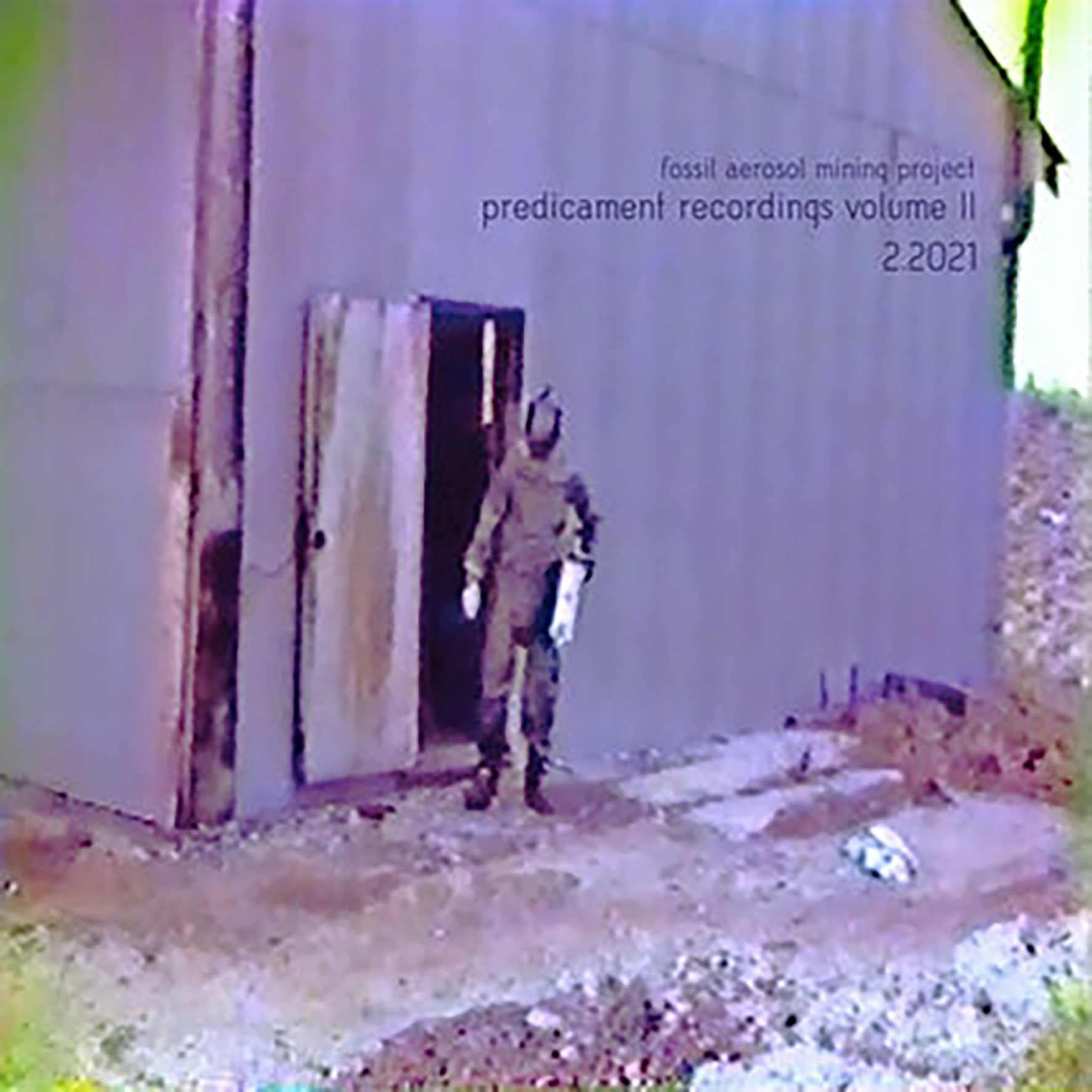
In characteristically enigmatic fashion, this inscrutable Illinois collective recorded a two-album series over the winter and opted to release the second part first. The two releases were conjured into existence during a brief "real-time, studio interaction" earlier this year, but the source material actually spans roughly a decade of scavenged sonic ephemera. If this were any other project, cannibalizing old recordings might be considered a "vault clearing" of sorts, but with Fossil Aerosol Mining Project, the whole point has always been to dig up long-forgotten shit from the past and repurpose it into something thoroughly weird and disturbing. Before this album, I was admittedly starting to wonder if this project was in a rut, as there have been a couple recent releases that I was less than enthusiastic about. However, it would be more accurate to say that this project is an unpredictably hit-or-miss one and this album is mostly a hit, as these murky nightmares nicely approximate an aesthetic best described as "what I hope to hear whenever I unearth some incredibly obscure yet revered '80s noise tape."
This particular album does not have an explicit conceptual theme lurking behind it (beyond the collective's usual morbid fascinations), but it does not exactly need one when the project's general vibe is nearly always some variation of "disturbing fever dream set in a George Romero movie." That said, the collective's vision has encompassed a few different strains of disorienting and creepy analog murk over the years and I tend to prefer the albums where some glimpses of melody, kitsch, or black humor brighten the pervasive atmosphere of rot, ruin, and existential horror. The humor this time is limited to the title's droll nod to the pandemic, sadly, but that is not a deal-breaker: if the spectral fragments that billow up out of the slime are compelling, I am always willing to submerge myself in Fossil Aerosol's seething miasma of tape loops and abandoned film canisters. The fragments in this case evoke a mysteriously abandoned secret military base in a malarial jungle, as the recurring themes seem to be ghostly machine hum, enigmatic loops of echoing voices, phantom radio transmissions, and a host of vaguely menacing "natural" sounds like buzzing insects and distant, muffled howls. In the closing "Passage Three" there is even an unexpected and visceral flurry of percussion, but it only emphasizes the existing dread further, resembling the war drums I might hear if I found myself suddenly dropped into Cannibal Holocaust. Fortunately, that has not happened to me yet, so I am free to wallow in the less extreme sensation of watching a cursed video cassette that makes everything around me curdle, wilt, rot, and corrode. Admittedly, few crave such a refined pleasure, but those who do will find an especially focused, tightly edited, and immersive Fossil Aerosol Mining Project experience here.
Samples can be found here.
Read More
- Anthony D'Amico
- Albums and Singles

This fascinating and inspired album is both the debut vinyl release from guitarist Jeremy Hurewitz and the first Flower Room album that is not a Matt Lajoie or Ash Brooks project. To some degree, that union makes perfect sense, as both Lajoie and Hurewitz are guitarists with healthy appetites for improvisation and psychedelia, but docile cobras takes those appetites into some impressively inventive and unfamiliar territory. While enhancing his acoustic guitar work with flutes, percussion, field recordings, and psychotropic electronic flourishes is nothing new for Hurewitz, this album is the fruit of a two-day collaboration with Mexican musician/folklorist Luís Pérez Ixoneztli, who oversees a "collection of priceless, one-of-a-kind, indigenous instruments from Mesoamerica." This is not a document of a jam with some unusual instruments, however, as Luís Pérez made his contributions only after listening to the pieces and thoughtfully reflecting upon the ideal accompaniment. Sometimes he opted for shakers made of dried cocoons or ancient clay flutes, but his instincts also led him to less traditionally musical sounds like "water poured into a tub" or "Shamanic breathing." To my ears, the result feels like a pleasantly lazy jam around a campfire, except I am wildly hallucinating and a displeased owl god just reawakened to punish me for blundering into his sacred clearing.
The album opens with some improvised-sounding variations on a vaguely Spanish or Middle Eastern acoustic guitar theme, which is normally not a promising sign for me. However, before I could start wondering if an actual song was going to appear, I was immediately drawn into the evocative and enigmatic backdrop of echoing drips and deep, whooshing breaths. Eventually "lost at sea" coheres into a kind of desert-psych crescendo, as Luís Pérez joins in with some shuffling percussion while additional layers of guitar weave an intricate web of melodies, but it illustrates an interesting and unusual aspect of Hurewitz's aesthetic: he seems extremely disinterested in songcraft in any kind of conventional sense. That said, the finished pieces each feel like part of an organic, complete, and a vividly realized vision, as the guitar parts serve as a thread guiding me through a phantasmagoric jungle of eerie, unfamiliar sounds pregnant with hidden meaning. However, there is one song ("peculiar travel suggestions") that is structured and melodic enough to approximate a "single," as Hurewitz even goes so far as to include a tender piano melody. Later, the rippling arpeggios of "shared consciousness" come within shouting distance of a conventionally structured song once more, but my favorite piece is the more loose, abstract, and epic "docile cobras." As usual, the most exquisite pleasures are not the chiming minor key arpeggios that act as the piece's backbone, but the rich panoply of mind-bending sounds that bleed slowly into the tableau with maximum hallucinatory impact. In fact, the piece even gets sucked into a still deeper black hole of psychedelia after I thought it had already reached peak mindfuckery, which is quite an impressive feat. The album as a whole is also quite an impressive feat, as Hurewitz and Luís Pérez cooked up one hell of a vibrant and memorably unique deep listening experience.
Samples can be found here.
Read More
- Anthony D'Amico
- Albums and Singles

No one can say that Randall Taylor is insufficiently committed to analog media, as the Portland-based tape wizard’s discography is teeming with cassettes released on a varied and international host of small labels. This latest release is one of his infrequent high-profile appearances, however, so Blooming can reasonably be viewed as the proper follow-up to 2018's Between Distant and Remote. In the interim, there were collaborations with Drowse and Midwife, both of which actually seem like closer stylistic brethren here than more purist tape projects like Tape Loop Orchestra (not always the case with Amulets). The album's precarious balance of sludgy, "doom-gaze" power chords and blurred, dreamy tape loops sometimes errs too much on the "doom" side to land Blooming a spot in my personal pantheon of favorite Amulet releases, but I am sure my highly subjective weariness of metal is a factor in that. That said, the line between "violent ambient" and "mannered, understated shoegaze-metal" is a blurry one and there is plenty that I love around that convergence. In fact, the occasions when Taylor perfectly hits the mark ("Observer Effect," for example) are damn near spellbinding. Also, it is quite impressive that Taylor has managed to make tape music so song-like and accessible that it could easily appeal to someone who has never heard of musique concrète.
Like many releases these days, Blooming was composed and recorded in isolation during the pandemic, which at least partially explains the album's darker-than-usual tone. More specifically, however, it was inspired by the flowers that Taylor encountered during his daily springtime walks, which triggered some deeper thoughts about how "nothing lasts forever and everything is cyclical." While Taylor is certainly not the first person to have that revelation, he is unusually good at applying that bittersweet wisdom to his art, as Blooming sustains a complex and shifting swirl of melancholy, decay, violence, fragility, and transcendent beauty for its entire duration. "Observer Effect," for example, slowly fades in with warmly dreamlike drones, tender arpeggios, and field recordings of sloshing waves, but ultimately coheres into an elegiac-sounding chord progression beneath a looping and gorgeously anguished-sounding hook. Elsewhere, "Collapse in Memory" is another triumph, as a warm sea of frayed and decaying loops gradually transforms into a considerably more heaving, violent, and stormy sea. The following "Empty Tribute" is also a jewel, as smoldering smears of tortured loops mass over a backdrop of industrial clatter. Even my not-favorite songs have their killer moments though, as the heartache reverie of "Tears in the Fabric" is beautifully ripped apart by an eruption of churning noise, while the closer "Whirl" offers a cathartic crescendo of looping howls. In fact, I suspect that I would absolutely love this album if it was a bit less moodily brooding and a bit more gritty and hiss-soaked. I do love Amulets in general, however, and can easily imagine that other fans of Taylor's work might view this as one of his most focused and powerful releases to date. For me, it is a solid album with two or three sustained flashes of "career highlight" brilliance.
Samples can be found here.
Read More
- Anthony D'Amico
- Albums and Singles
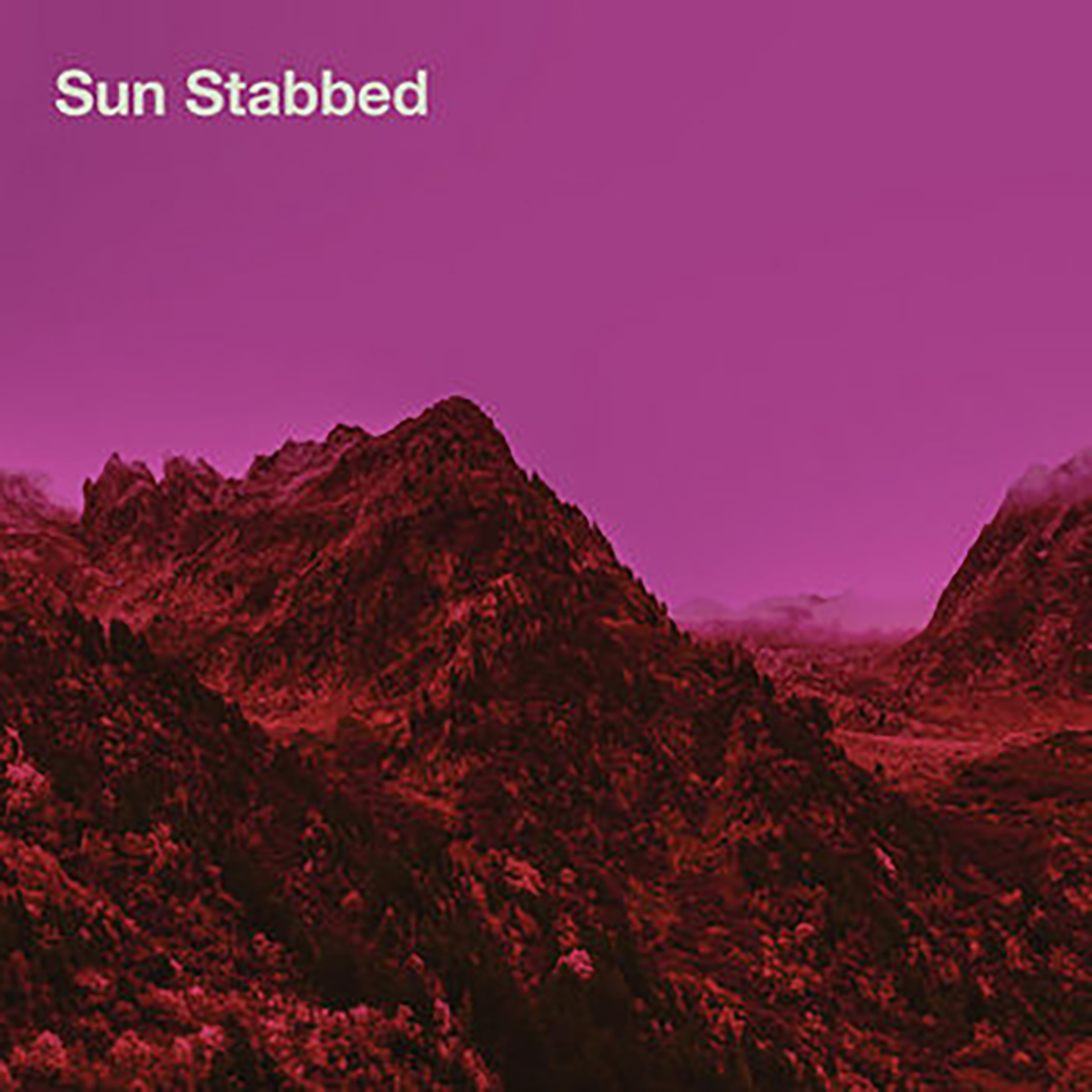
It has been roughly a decade since this French duo of gnarled guitar enthusiasts last surfaced as Sun Stabbed and I have certainly missed them, though Thierry Monnier and Pierre Faure's similarly excellent La Morte Young project helped fill the void nicely. Aside from the different line-ups, the main difference between the two projects is that this one is kind of a direct homage to some of New Zealand's most iconic purveyors of blacked drones and noisy guitars. While no discussion of that subject would be complete without Campbell Kneale, it is The Dead C and the woefully underheard Surface of the Earth that explicitly provide the most inspiration here.  Characteristically, Monnier and Faure are admirably up to the task of continuing that fine tradition, as In Girum Imus Nocte Et Consumimur Igni is a feast of manipulated feedback, burned-out wreckage, and simmering drones. Occasionally it can be eerily beautiful and haunting, but I also like the parts that resemble an onstage brawl between Skullflower and Sunn O))). This is an instant noise/drone guitar classic.
The album opens with its most slow-burning pleasure, as "Le soleil couchant de cette cité laissait quelques lueurs" opens with a single distorted tone that lazily twists and undulates for several minutes. As that note drones on, a haze of feedback and overtones starts to form around it and the higher pitches begin to resemble Tuvan throat singing. Eventually the central drone is fleshed out a bit, but the piece continues to feel like a single smoldering and gently twisting drone loaded with seething tension. It is a beautifully crafted piece, but I appreciated it even more once I translated the title (roughly "The setting sun of this city left some light"), as I started envisioning all of the slowly unfurling tendrils of sound as streaks of deep red and bruised purple in the darkening wake of a sunset (definitely made me wish I had synesthesia). The following "La sensation de l'écoulement du temps" is another slow-building masterpiece of controlled violence and superhuman patience, as ghost trails of feedback lazily wind across a landscape of drones and gently sizzling and crackling amp noise. The neat twist this time around is that the spectral feedback and the underlying drones both cohere into rhythmic patterns that are as languorously hypnotic as any Indian raga I have heard. Sun Stabbed differ from raga in some very significant ways though, particularly in the passing storm of stuttering, blown-out distortion that soon consumes the song. Yet another perfectly titled piece (roughly "So here is a civilization that burns, capsizes and sinks in its entirety") closes this album with a convulsive catharsis of roiling guitar noise and buzzing, low-end hum. It is not quite on the same level as the previous two pieces, but compensates with its comparative brevity and provides an enjoyably volcanic finale.
Samples can be found here.
Read More
- Eve McGivern
- Albums and Singles
 Detroit-based project Mission to the Sun is Christopher Samuels (Ritual Howls) and vocalist Kirill Slavin. For those familiar with Ritual Howls’ catalog, there are brooding melodies and electronic forays akin to that band, but listeners will not mistake this for a Ritual Howls release. Cleansed by Fire’s modus operandi is founded on minimal ambient electronics that serve as the foundational context for Slavin’s bleak lyrics and haunting vocals.
Detroit-based project Mission to the Sun is Christopher Samuels (Ritual Howls) and vocalist Kirill Slavin. For those familiar with Ritual Howls’ catalog, there are brooding melodies and electronic forays akin to that band, but listeners will not mistake this for a Ritual Howls release. Cleansed by Fire’s modus operandi is founded on minimal ambient electronics that serve as the foundational context for Slavin’s bleak lyrics and haunting vocals.
When it works, it does so to significant effect, particularly on "Damaged." Vocals set back in the mix provide a robust and brooding balance between Samuels’ sad synthesizer melody and gloomy lyrics, crying, "I tried to reach the sky, but I burnt out." Instrumental "Mission to the Sun" is a standout track that brokers a hypnotic industrial rhythm splashed with fuzz and interspersed with ghostly and staccato vocals.
Some songs come off as more challenging in that they start slow and straightforward, sounding as if they are building towards a grand finale that never arrives. ("Take Me Back," "Three Crossings") That said, concert rock this is not - far from it - intending instead to invoke a contemplative if darker mood. Consider "The Unbroken Sea," founded on a straightforward underlying synth melody; from here, carefully listen as it becomes embellished with soft static, wind effects, and the occasional ghost chorus. The lyrics match the mood, with Slavin matter-of-factly imploring the listener to "Take all my possessions / Release me from confession / Drain me of ability / In the deepest water / Just waiting for the slaughter." None of Mission to the Sun’s melodies are as direct as those of Ritual Howls, but patience will reward with darker gems of a different sort.
Samples can be found here.
Read More
- Anthony D'Amico
- Albums and Singles
 It is unfortunate that this final album from Tomaga is being released in the shadow of Tom Relleen's untimely passing, as Intimate Immensity probably could have been the London duo's breakthrough release otherwise. I first became aware of the project through a combination of drummer Valentina Magaletti's many other appearances (Vanishing Twin, Raime, Helm, etc.) and stumbling upon Memory in Vivo Exposure while briefly obsessed with exotica-inspired ambiance. While I would not describe this latest album as particularly exotica-inspired for a Tomaga release, Relleen and Magaletti have always had a unique, eclectic, and constantly evolving off-beat vision, so there is no dearth of unusual juxtapositions and unexpected divergences among these ten songs. I suppose Vanishing Twin's Stereolab-esque aesthetic is as good a reference point as any, as the best songs here feel like the soundtrack of an arty European cult film from the '60s or '70s improved with subtle hallucinatory flourishes, exotic atmospheric touches, and muscular dub-wise grooves.
It is unfortunate that this final album from Tomaga is being released in the shadow of Tom Relleen's untimely passing, as Intimate Immensity probably could have been the London duo's breakthrough release otherwise. I first became aware of the project through a combination of drummer Valentina Magaletti's many other appearances (Vanishing Twin, Raime, Helm, etc.) and stumbling upon Memory in Vivo Exposure while briefly obsessed with exotica-inspired ambiance. While I would not describe this latest album as particularly exotica-inspired for a Tomaga release, Relleen and Magaletti have always had a unique, eclectic, and constantly evolving off-beat vision, so there is no dearth of unusual juxtapositions and unexpected divergences among these ten songs. I suppose Vanishing Twin's Stereolab-esque aesthetic is as good a reference point as any, as the best songs here feel like the soundtrack of an arty European cult film from the '60s or '70s improved with subtle hallucinatory flourishes, exotic atmospheric touches, and muscular dub-wise grooves.
I would not describe myself as particularly drum-obsessed, but there are definitely a handful of drummers and percussionists who are reliably compelling when freed from the constraints of conventional songs and Valentina Magaletti is one of them. She is a bit of an aberration in that regard though, as she tends to churn out killer beats rather than wild, free-form solos. Tomaga has long been the home for those killer beats and Relleen is the perfect foil on Intimate Immensity, enhancing Magaletti's grooves with deep, dubby bass motifs, evocative splashes of color, and eclectic melodic themes. In some ways, Muslimgauze is another one of Tomaga's closest kindred spirits, but if Bryn Jones had not been monomanically obsessed with the Middle East and had instead spent his time in tiki bars watching Serge Gainbourg and Guy Maddin films and obsessively absorbing every weird soundtrack that Finders Keepers reissues.  In that light, the album's best song is a bit of an anomaly, as "Intimate Immensity" has the feel of a bizarrely sensual, tripped-out elegy, as an achingly lovely descending string motif floats above a slowed-down "Funky Drummer"-style beat and rubbery, ping-ponging electronics. The industrial-tinged "British Wildlife" is a delight as well, resembling a Carter Tutti remix of a Martin Denny album, yet the album's most sustained run of greatness occurs mid-album, as "The Snake," "Very Never," and "More Flowers" are all cool as hell. All sound very cinematic and would be perfect for a late '60s spy movie set in Marrakech or my next escape from a haunted tropical island, but the alternately rolling and lurching grooves ensure that they feel like something for more visceral and vivid than a mere pastiche of cool influences. While I have not quite made it through Tomaga's entire discography yet, I would be extremely surprised if any of the duo's previous albums surpass this one, as the highlights here feel impressively revelatory.
Samples can be found here.
Read More
- Anthony D'Amico
- Albums and Singles
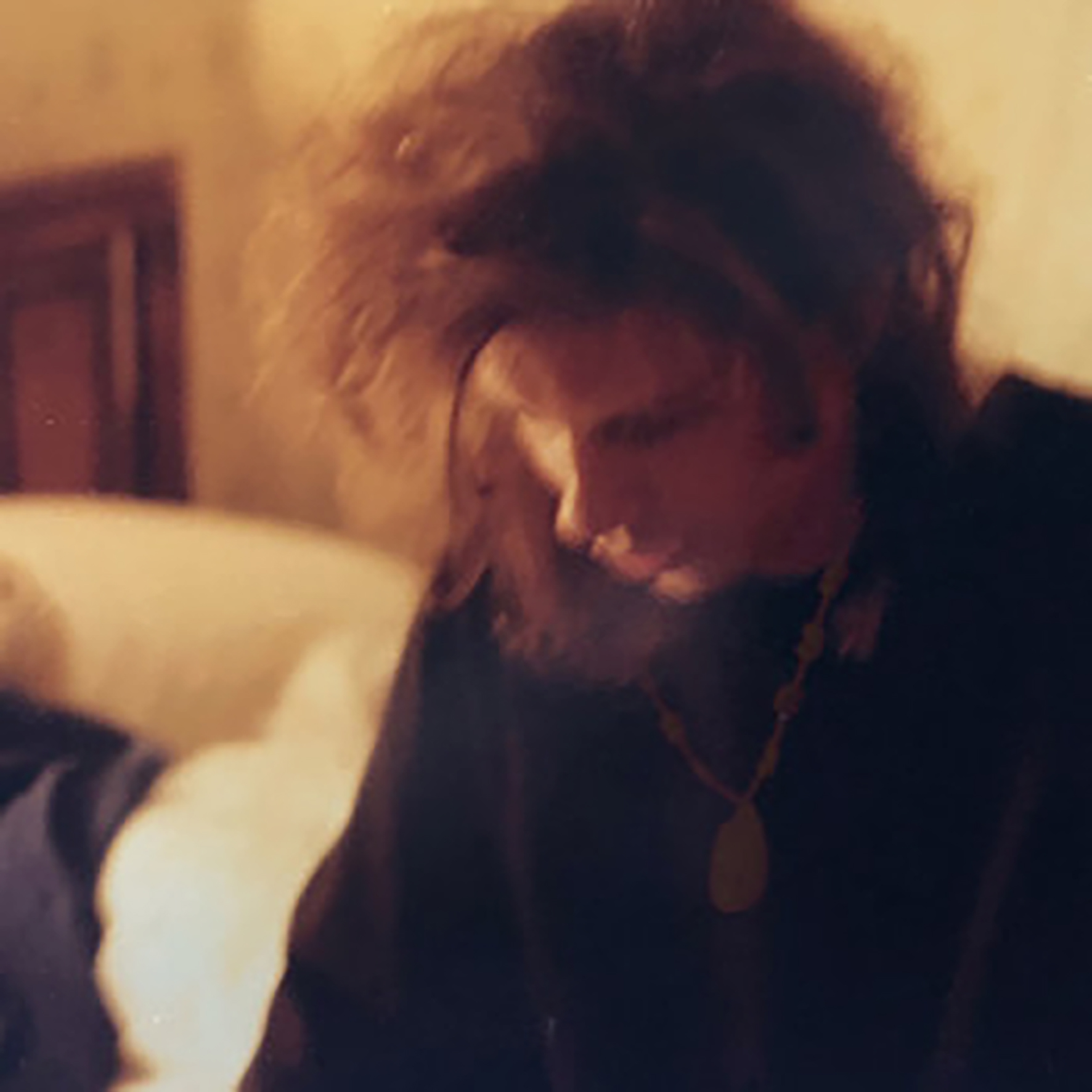 Disciples' wonderful series of resurrected home recordings from Warren Defever's precocious teenage years winds to a close with this third album (coinciding with the release of A Silver Thread, which compiles all of Defever's recently issued early home recordings in one place). In one way, it can be said that the best was saved for last, as Hope is a Candle features remastered versions of some material from the demo that fatefully landed His Name is Alive on 4AD (which has circulated as a bootleg for years). To my ears, however, it does not quite rival the pleasures of All the Mirrors in the House, but that makes sense since Mirrors was the revelatory bombshell that unveiled this treasure trove in the first place. That said, the "songs" are sometimes a bit longer and more fleshed out this time around, making Hope is a Candle feel like an enjoyable outtakes collection from the project's earliest albums. While that is certainly enough to satisfy me as an HNIA fan, the album also boasts quite a lovely and sublime closing piece.
Disciples' wonderful series of resurrected home recordings from Warren Defever's precocious teenage years winds to a close with this third album (coinciding with the release of A Silver Thread, which compiles all of Defever's recently issued early home recordings in one place). In one way, it can be said that the best was saved for last, as Hope is a Candle features remastered versions of some material from the demo that fatefully landed His Name is Alive on 4AD (which has circulated as a bootleg for years). To my ears, however, it does not quite rival the pleasures of All the Mirrors in the House, but that makes sense since Mirrors was the revelatory bombshell that unveiled this treasure trove in the first place. That said, the "songs" are sometimes a bit longer and more fleshed out this time around, making Hope is a Candle feel like an enjoyable outtakes collection from the project's earliest albums. While that is certainly enough to satisfy me as an HNIA fan, the album also boasts quite a lovely and sublime closing piece.
Now that this wonderful series of archival finds is (probably) at an end, it occurs to me that its appeal often lies more in hearing what a bored teenager with limited resources can achieve with sufficient vision than as a window into how the early His Name is Alive aesthetic took shape. After all, there are already several great HNIA albums out in the world, but getting a glimpse into how the young and extremely resourceful Defever worked around his limitations is considerably more instructive and inspiring. As Defever himself put it, "I wanted to do my own Music For 18 Musicians. But I didn't know 18 musicians; I barely had two friends, and even they couldn't stand me." While nothing on Hope is a Candle is in any danger of being mistaken for a classic Steve Reich composition, the album does feature an impressively varied and inventive series of song sketches. The strongest is the aforementioned closer, "Insiders," which is a warmly lovely and slow-moving procession of shimmering chord swells. "Liadin," the album's single of sorts, is a gem as well, as Defever deftly combines slow, chorus-heavy washes of chords with airy, jangling strums. Elsewhere, the swirling, reverb-swathed orchestral loops of "Nearby" are another sublime delight. That said, while Hope is a Candle does feature some song-like moments, it still does not quite reach the "songs" stage, so it has the feel of a collection of ephemeral highlights plucked from a mountain of improvisations (which is exactly what it is). At various times throughout this series, some unearthed pieces have transcended those origins beautifully, but the bulk of this album falls more within the "cool vignettes" category. Some of those vignettes ARE quite good though, particularly the all-too-brief harmonized acoustic guitar interlude of "Never" and the droning bowed strings and sharp harmonics of "Still."
Samples can be found here.
Read More
- Anthony D'Amico
- Albums and Singles
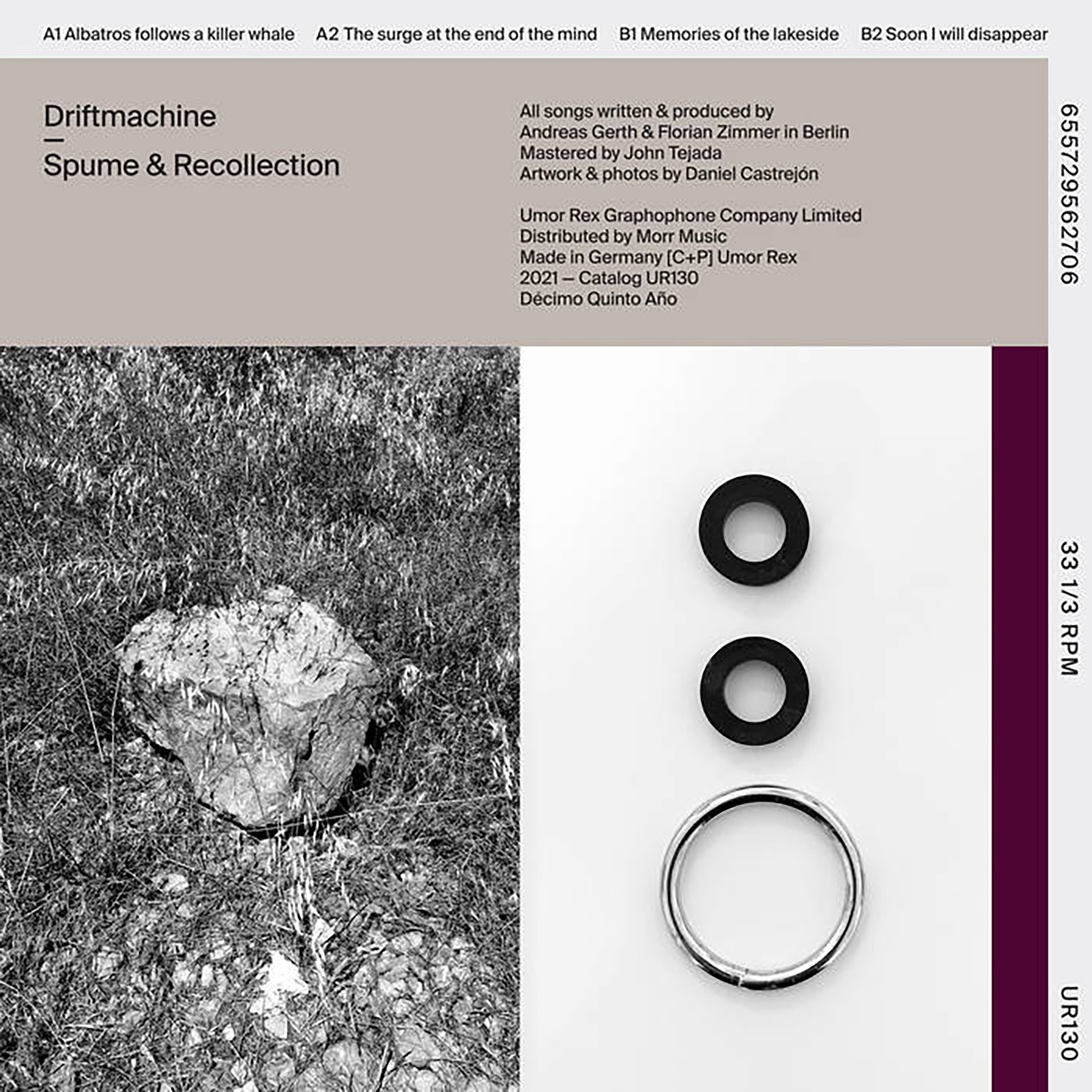 I have belatedly realized that I was an utter fool for sleeping on this unusual electronic duo from Berlin for so long, as an idiosyncratic dub techno-inspired project from a former member of Lali Puna seems like it should be right up my alley. Unfortunately, their debut (Nocturnes) was a bit too indulgent, deconstructed, and eclectic to resonate with me at the time and I filed them away as "mutant techno for people who are way too enthusiastic about modular synthesizers." Whether Driftmachine has gotten better in the ensuing seven years or whether I just caught up to the inspired aesthetic that they had all along is hard to say, but Spume & Recollection instantly sounded great to me, so my guess is that there have indeed been some improvements. While all four of these pieces are definitely still a bit too vamp-like and strange to fit within my personal dub techno comfort zone, I now feel like the quirks and subdued spaciness of the pair's vision make Driftmachine a compelling entity in its own right, as the best moments of Spume & Recollection feel like simmering, surreal, and mechanized psychedelia in perfectly distilled form.
I have belatedly realized that I was an utter fool for sleeping on this unusual electronic duo from Berlin for so long, as an idiosyncratic dub techno-inspired project from a former member of Lali Puna seems like it should be right up my alley. Unfortunately, their debut (Nocturnes) was a bit too indulgent, deconstructed, and eclectic to resonate with me at the time and I filed them away as "mutant techno for people who are way too enthusiastic about modular synthesizers." Whether Driftmachine has gotten better in the ensuing seven years or whether I just caught up to the inspired aesthetic that they had all along is hard to say, but Spume & Recollection instantly sounded great to me, so my guess is that there have indeed been some improvements. While all four of these pieces are definitely still a bit too vamp-like and strange to fit within my personal dub techno comfort zone, I now feel like the quirks and subdued spaciness of the pair's vision make Driftmachine a compelling entity in its own right, as the best moments of Spume & Recollection feel like simmering, surreal, and mechanized psychedelia in perfectly distilled form.
The curiously titled "Albatross follows a killer whale" opens the album with bleary, swaying smears of synthesizer and lazy beeps before a slow and deep bass groove kicks in. From that point onward. Driftmachine continually display a real knack for crafting hypnotically stark and throbbing rhythms, always finding the perfect tempo for their heady, simmering magic to slowly reveal itself. In the case of "Albatross," that magic comes in the form of shuddering, buzzing drones and dubby slashes of echoing percussion. Without the latter, the piece would still be a pleasantly slow-burning dub techno-inspired delight, but the unpredictable violence of those slashes elevate it into something better. The following “The surge at the end of the mind” kicks off with a blurting and lurching off-kilter pulse, resembling some kind of stark, robotic funk (a good summation of the entire album, really). Gradually, however, the strange collection of clicks, pops, swells, and beep coheres into an unexpectedly propulsive groove. Or maybe an expectedly propulsive one, as Driftmachine are unerring in that regard on this album. The duo's rhythms are unconventional though, involving a number of moving parts that rarely seem like they will seamlessly lock together into a precision-engineered, futuristic pulse (and yet they always do). Elsewhere, “Memories of the lakeside" comes out of the gate with an odd, quirky groove that achieves something akin to imagining "Hotline Bling" as a classic Rhythm & Sound single. The final piece, "Soon I will disappear," is an unusually melodic one, as a minor key chord progression of frayed, spectral synths unfolds over a characteristically erratic and bubbling synth pulse. Of course, once the kick drum and the bass come in, yet another smoky, simmering, and heavy groove is born. All four pieces here are legitimately excellent and quite similar to one another, as Spume & Recollection is essentially just a handful of cool grooves allowed to play out in ten-minute doses, yet the duo's surgical exactitude, flawless instincts, and talent for manipulating small details keep the album smoldering from front to finish.
Samples can be found here.
Read More
- Anthony D'Amico
- Albums and Singles
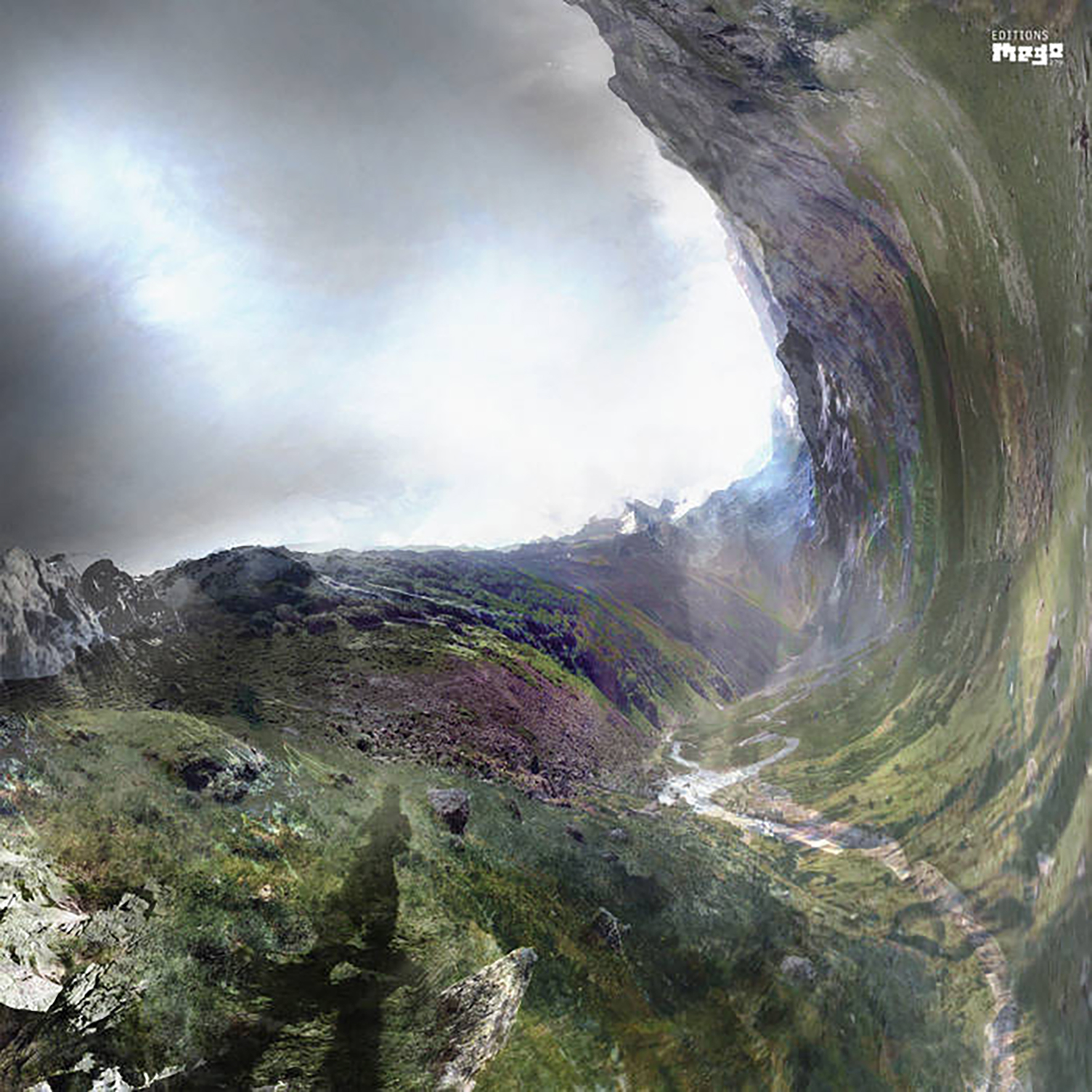 I was completely floored by the opening "Fantas" when I first heard 2019's Ecstatic Computation, so I was thrilled to discover that it was unexpectedly getting its own well-deserved album of remixes. Given the brilliance of "Fantas" itself and the circle of talented and unusual artists surrounding Barbieri, I never had any doubt that I would enjoy Fantas Variations immensely, but I was still pleasantly surprised by the unexpected directions that some of these variations took, as the source material is damn near unrecognizable in some cases (especially in Evelyn Saylor's startling opener). Naturally, much of the album's draw for me lies in hearing what reliably great familiar names like Kara-lis Coverdale and Kali Malone could do with Barbieri's intense synth opus and I was not disappointed in that regard. However, it is primarily the more unfamiliar artists (to me, at least) who steal the show, particularly on Bendik Giske's haunting saxophone variation and Jay Mitta's hyperkinetic snare freakout that resembles an unhinged, psychedelic Latin dance party or polka-themed nightmare.
I was completely floored by the opening "Fantas" when I first heard 2019's Ecstatic Computation, so I was thrilled to discover that it was unexpectedly getting its own well-deserved album of remixes. Given the brilliance of "Fantas" itself and the circle of talented and unusual artists surrounding Barbieri, I never had any doubt that I would enjoy Fantas Variations immensely, but I was still pleasantly surprised by the unexpected directions that some of these variations took, as the source material is damn near unrecognizable in some cases (especially in Evelyn Saylor's startling opener). Naturally, much of the album's draw for me lies in hearing what reliably great familiar names like Kara-lis Coverdale and Kali Malone could do with Barbieri's intense synth opus and I was not disappointed in that regard. However, it is primarily the more unfamiliar artists (to me, at least) who steal the show, particularly on Bendik Giske's haunting saxophone variation and Jay Mitta's hyperkinetic snare freakout that resembles an unhinged, psychedelic Latin dance party or polka-themed nightmare.
Evelyn Saylor’s hazy and cooing a capella opener sets the bar quite high for bold and audacious interpretations of Barbieri's work, as it almost sounds like it could be a lost vocal movement from Steve Reich's Music for 18 Musicians, but with a more pronounced vocal jazz influence and some surprisingly intense wails near the end. Later on the album, however, Baseck turns up with the infinitely more bananas "Fantas Hardcore," which sounds like it should be the soundtrack to sped-up footage of some first-person shooter video game or a supernaturally intense rave. Neither of those left-field surprises rank among my favorite pieces on the album, but they certainly illustrate how adventurous and wild some of Barbieri's collaboration choices can be. On the more "safe" end of the spectrum, Walter Zanetti seamlessly transposes "Fantas" for guitar to approximate something akin to a mesmerizing Emeralds demo tape, while both Kali Malone and Kara-lis Coverdale beautifully adapt the piece to their own aesthetics (a breathy, slow-motion pipe organ reverie and a delicate, spidery solo piano performance, respectively). Carlo Maria, on the other hand, turns the piece into a driving bit of thumping synth-driven psychedelia that arguably recalls Emeralds again, but a considerably sexier and more dancefloor-driven incarnation of the band. As great as all of that can be, it is unquestionably Bendik Giske's smoldering and serpentine "Fantas for Saxophone and Voice" that stands as the album’s most obvious and instantly gratifying masterpiece, though I am also greatly charmed by Jay Mitta’s half-brilliant/half-ridiculous vision of simply playing the original song, but adding some crazily over-the-top and relentless snare rolls to it. While I never expected Fantas Variations to eclipse Ecstatic Computation, I am nevertheless surprised at how well it succeeds as a weirder and more fun sister album.
Samples can be found here.
Read More
- Anthony D'Amico
- Albums and Singles
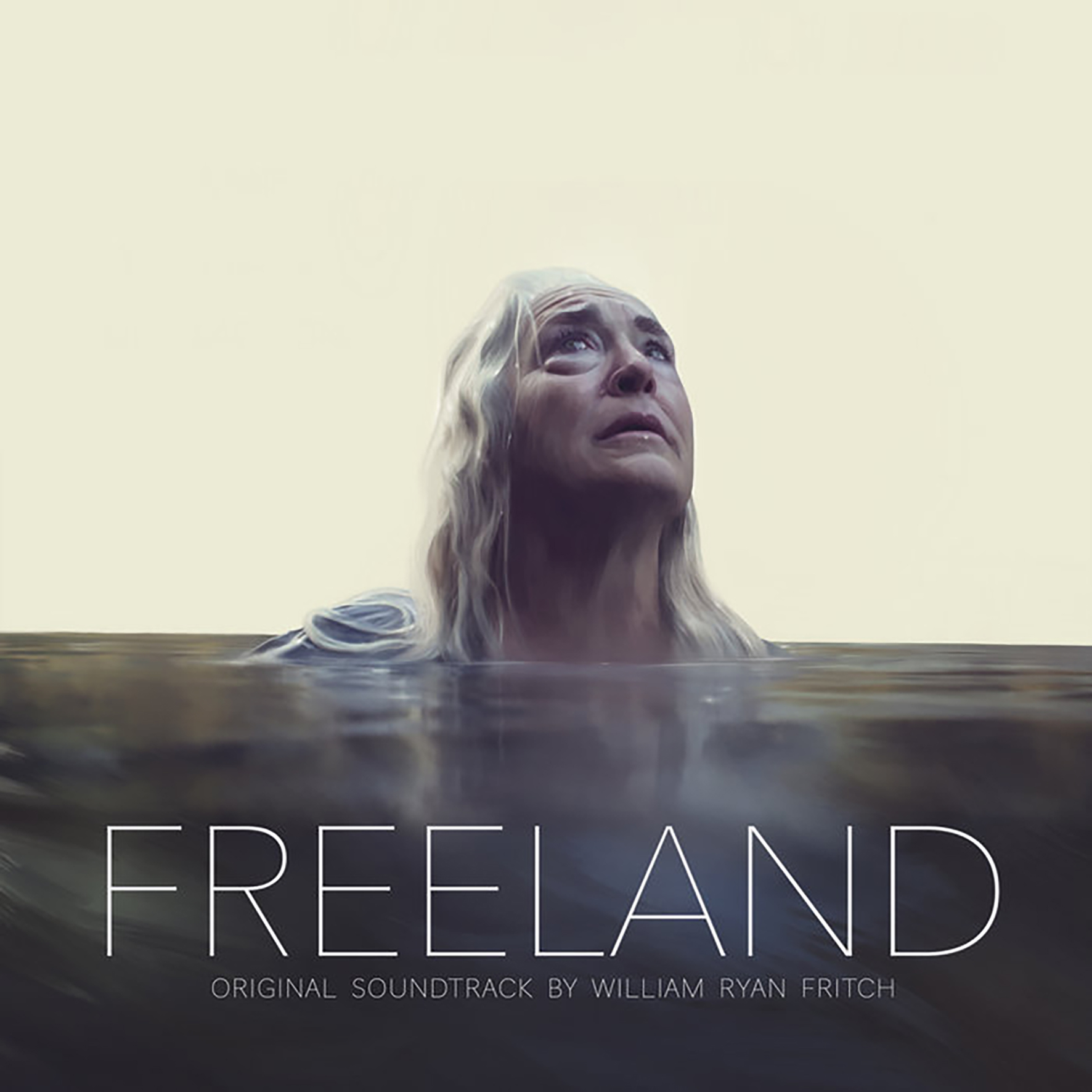 It seems like William Ryan Fritch has a new album coming out practically every other month these days and I dearly hope to catch up with his voluminous output someday, as that relentless work ethic does not seem like it has disrupted his near-supernatural hot streak one bit. This latest gem is one of his more high-profile recent releases, billed as a labor of love two years in the making. Normally, soundtrack albums are a bit of a red flag for me, as they are not generally intended to stand alone (by design), but some artists can transcend that restriction beautifully and conjure vivid sound worlds that are satisfying and complete experiences in their own right. Unsurprisingly, Fritch is one such artist and Freeland is an absorbing, inspired, and fitfully mesmerizing album. Granted, some of the strongest pieces are teasingly brief due to their intended context, but the heaving, shuddering, and fluttering rustic drones of pieces like "Devi’s Last Deal" and "The Old Commune" are haunting and memorable enough that I do not lament their brevity much, as I will happily take whatever glimpses of heaven I can get.
It seems like William Ryan Fritch has a new album coming out practically every other month these days and I dearly hope to catch up with his voluminous output someday, as that relentless work ethic does not seem like it has disrupted his near-supernatural hot streak one bit. This latest gem is one of his more high-profile recent releases, billed as a labor of love two years in the making. Normally, soundtrack albums are a bit of a red flag for me, as they are not generally intended to stand alone (by design), but some artists can transcend that restriction beautifully and conjure vivid sound worlds that are satisfying and complete experiences in their own right. Unsurprisingly, Fritch is one such artist and Freeland is an absorbing, inspired, and fitfully mesmerizing album. Granted, some of the strongest pieces are teasingly brief due to their intended context, but the heaving, shuddering, and fluttering rustic drones of pieces like "Devi’s Last Deal" and "The Old Commune" are haunting and memorable enough that I do not lament their brevity much, as I will happily take whatever glimpses of heaven I can get.
As the opening piece is the achingly beautiful "Devi's Last Deal," I did not need any added convincing to help me fall in love with the album, but my appreciation for Fritch's vision actually did deepen a bit once I learned more about the film. In broad strokes, Freeland is about "an aging pot farmer" who "finds her world shattered" as the legalized weed industry threatens to destroy her fragile outlaw refuge of hippie idealism (and her livelihood). Given the trailer, the tone of the music, and the choice of the elementally intense Krisha Fairchild for the lead role, it is probably safe to say I will find the film heartbreakingly sad when I finally see it, as powerlessly watching capitalism consume counterculture is certainly a subject that resonates with me. In keeping with that theme, Fritch's music evokes flickering and ghostly memories of distant happier times in a long-abandoned commune. If that spectral commune had a spectral house band, it would probably be a drowned orchestra of moss-covered skeletons rather than more expected "commune fare" like Amon Düül II or the freak folk milieu, as the slow, sad drones are invariably organic, haunted, and haunting. There are also a couple of shimmering and radiant pedal steel-sounding interludes ("Bygones" and "What You've Built"), as well as a tenderly melodic and dreamlike piano piece (the closing "Resurface"). All are likable, but it is definitely the more drone-based pieces that make me think "no one could have made a better soundtrack for this film than William Ryan Fritch, as he is a goddamn textural sorcerer." In pieces like "The Old Commune" and "Dropped," the strings sound like the deep, heaving, and woody groans of an old forest, while the woodwinds breathily sigh and flutter like phantasmagoric birds and butterflies. When Fritch stretches out enough to conjure a sublimely immersive and bittersweet scene in vivid detail, the results are gorgeous. Admittedly, only a handful of pieces linger around long enough to make such an impression on their own, but these fourteen fragments cumulatively make for quite a memorable whole.
Samples can be found here.
Read More
- Administrator
- Albums and Singles

Indeed, You ARE hallucinating but you have absolutely nothing to fear. Just 'go with the flow.'
This small but wildly colorful monument will emerge in 3 different formats in the months to come. Vinyl and cassette will be courtesy of Witch Cat Records in Denver. The double CD will materialize via The Dots' own Terminal Kaleidoscope label.
Erik Drost - Guitars, Bass;
The Silverman - Keyboards, Devices;
Edward Ka-Spel - Voice, keyboards.
Special guests:
Patrick Q. Wright - Violins, keyboards on 2;
Quentin Rollet - saxes, sopranino sax on 1,4,5,8,9.
Produced and Engineered by EK.
Cover concept and photography by Alena.
More information can be found here.
Read More

